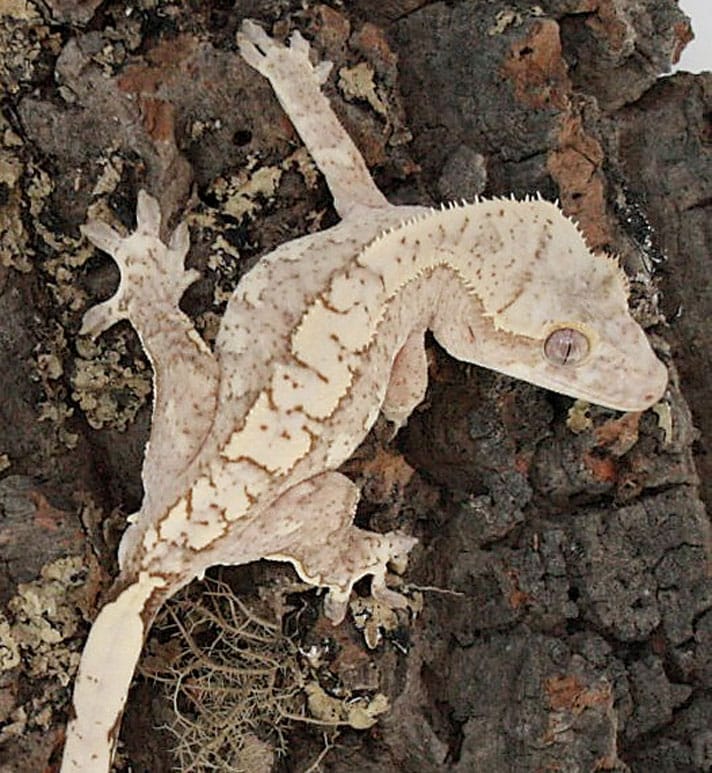Find out why some people consider the crested gecko a living work of art.
In recent years the crested gecko (Correlelophus [formerly Rhacodactylus] ciliatus), has been taking the pet industry by storm. This endearing gecko may even now rival the leopard gecko (Eublepharis macularius) as the most sought-after pet by gecko enthusiasts. Also known as the eyelash gecko, the crested gecko is native to a cluster of islands east of Australia known collectively as New Caledonia. It was once thought to be extinct, but a 1994 expedition led by Wilhem Henkel and Robert Seipp led to the rediscovery of this elusive creature. Soon after, Allen Repashy, Philippe de Vosjoli and Frank Fast followed in order to collect specimens, and the legal export and introduction of the crested gecko into the pet trade soon followed. Ever since then, the popularity of this hardy and visually astounding gecko has grown exponentially.
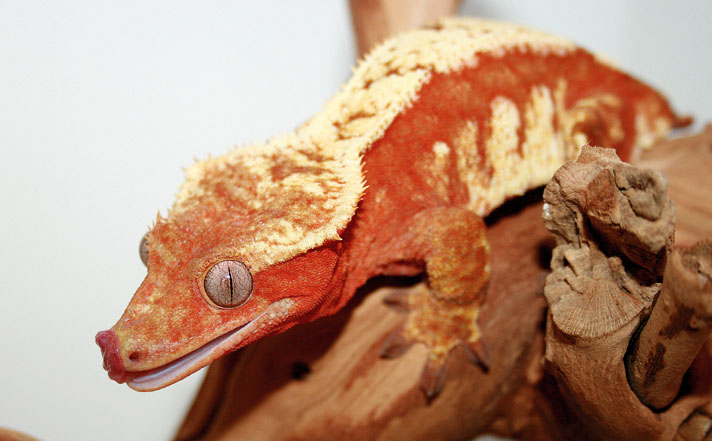
Kimberly Kay Lucas
Red cream solid harlequin crested gecko morph.
In the wild, this small, nocturnal gecko thrives among the lower-level trees and foliage in the temperate forest climate of New Caledonia, hiding tucked into plants during the day and feeding on rotting fruit and insects at night. An adult weight for both males and females can be anywhere from 38 to 70 grams, with a length of 8 to 10 inches, half of which includes the prehensile tail.
Although its coloration in the wild tends to be earth tones of brown, green and red, years of selective captive breeding have resulted in crested geckos now being available in an array of colors and patterns. It is this gecko’s polymorphic trait that has sparked the interest of so many. One of the most hardy and low-maintenance geckos available today, it can make a wonderful pet the entire family can enjoy. “Cresteds,” or “cresties,” as they are commonly called, are docile in nature and relatively calm and easy to handle as pets. The gecko gets its common name from the crests that run along both sides of its diamond-shaped head. Although it may look prickly, a crested gecko’s skin actually has a soft, suede feel to it. It has no eyelids, but a large scale called a brille protects each of its eyes.
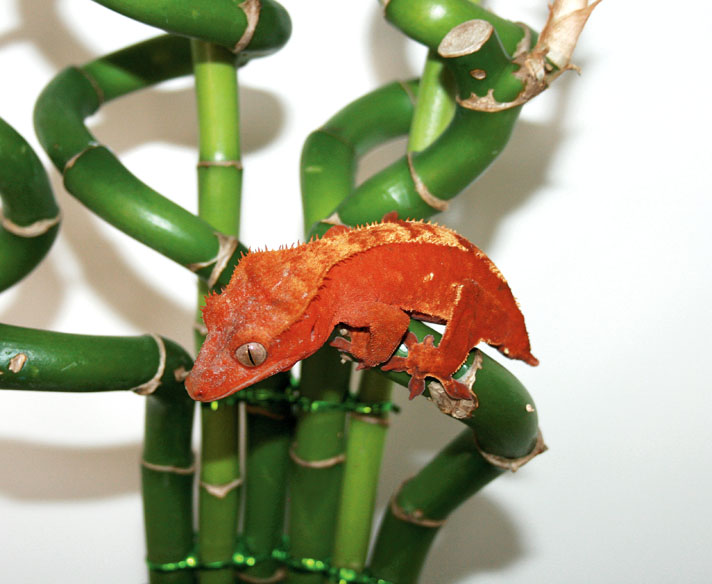
Kimberly Kay Lucas
Sorbet partial pinstripe crested gecko morph.
One of the crested gecko’s most fascinating and entertaining abilities is being able to clean its eyes with its tongue. You will often see them licking their eyeballs after a good misting. Look closely, too, to see the crested gecko’s trademark hint of a smile. And as if these physical attributes were not endearing or interesting enough, the crested gecko also has sticky toe pads equipped with lamellae (microscopic cilia hairs) that allows it to climb vertical surfaces with ease.
How to Pick a Healthy Crested Gecko
A healthy crested gecko will be lively and alert when handled. It should have a clear ear vent and nose, smooth skin, and adults should have a little heft to them. Sunken eyes and wrinkly skin could be a sign of dehydration, and an extremely lethargic gecko might be sick.
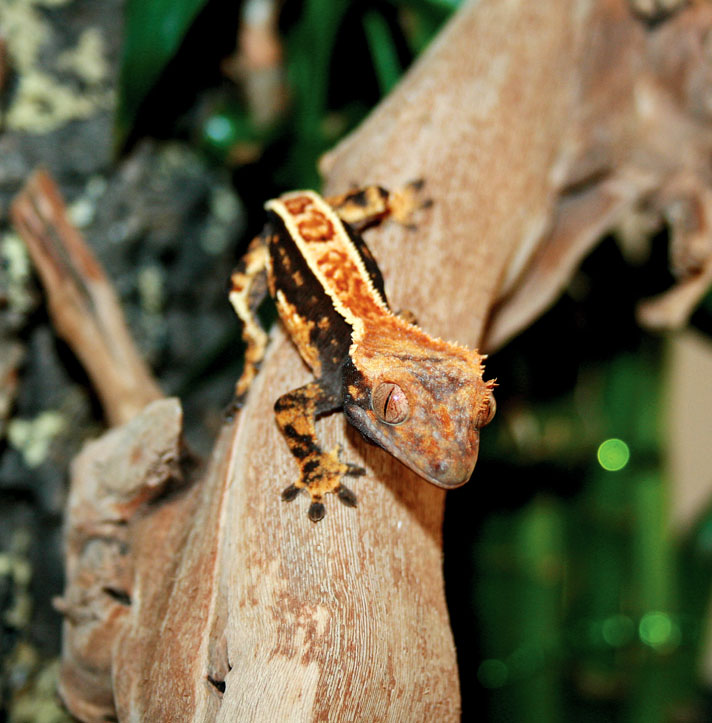
KIMBERLY KAY LUCAS
Calico high-contrast full pinstripe crested gecko morph.
The most common health concern in regard to crested geckos is metabolic bone disease, which is caused by a severe calcium deficiency. It will present itself as tremors, a jutting lower jaw, or kinks and bowing in the gecko’s spine or tail. Avoid any geckos exhibiting these characteristics by choosing a reputable breeder or pet store from which to purchase your crested gecko. Not everyone who has bred and produced crested geckos should be considered a reputable breeder. Pictures of the facility, care sheets, veterinarian and or animal health facility inspection records should be available for you to view. Whether you are purchasing your crested gecko from a store, a professional breeder or a hobbyist breeder, be sure you will be able to speak with someone directly about the gecko(s) you are considering purchasing.
When adding a new gecko to an existing colony, a minimum 60-day quarantine period is required. I always recommend taking a fecal sample to your vet right away to check for pin worms, hookworms or other parasites. These can piggyback on some feeder insects and be ingested in small doses, and it is common for reptiles to harbor a small parasite load without showing signs of ill health. Then all it may take is a stressful situation, such as moving your gecko’s habitat or a change in enclosure temperature, to create a window of opportunity for a parasite to thrive and make your gecko sick.
Although not common, more serious invaders such as Cryptosporidium, Entamoeba and bacterial infections can also be detected by a fecal test and examination by a veterinarian.
The Best Crested Gecko Habitat
Because of this gecko’s arboreal nature, the height of a crested gecko enclosure is more important than its length. A Plexiglas or glass enclosure measuring 23 inches tall by 16 inches wide by 15 inches deep can comfortably house a couple of adult crested geckos. Do not house more than one adult male together because they will most likely fight. Younger geckos can be housed in groups in smaller enclosures and thinned out to smaller groups when moved to larger enclosures as they grow.
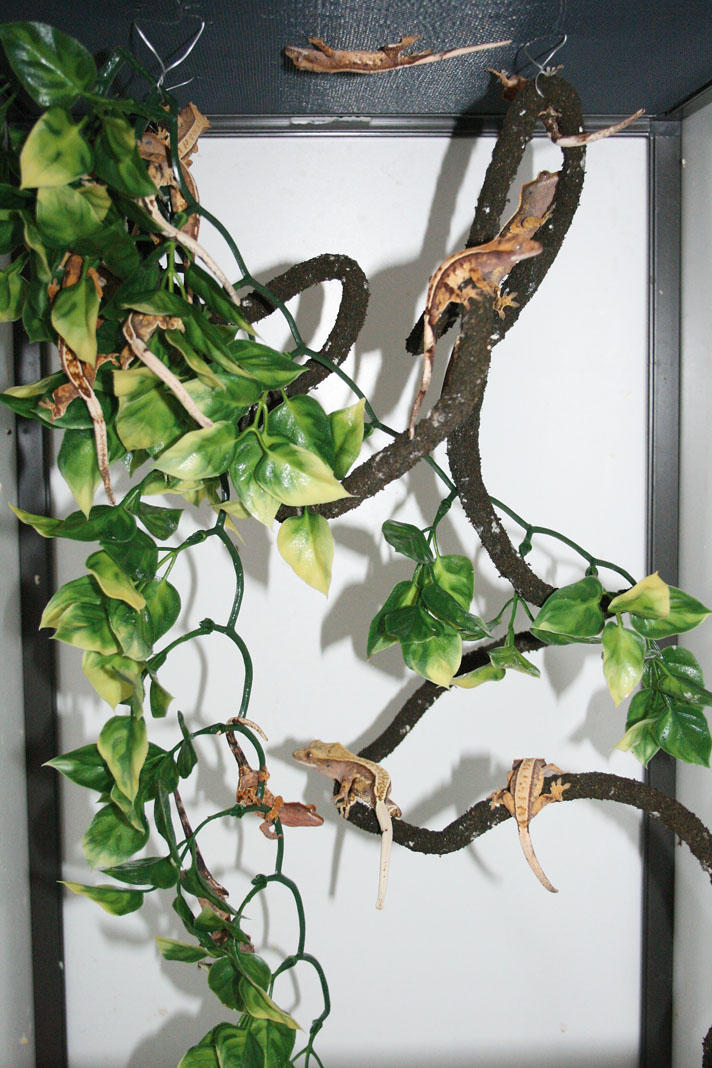
KIMBERLY KAY LUCAS
A community of baby geckos in a typical arboreal crested gecko enclosure.
Baby crested geckos can thrive in a 5- or 10-gallon aquarium fitted with a screen lid for several months. Eventually, they should be moved to a 12 x 12 x 18-inch-tall enclosure, and larger as they grow. A smaller enclosure allows younger geckos to easily find food and water, without being overwhelmed by an overly large space.
Choose an enclosure that is solid on at least three of its four sides in order to retain proper humidity inside it. A screen top and front panel will provide plenty of ventilation while still being able to retain humidity better than an all-screen enclosure. To create more humidity in an all-screen enclosure, fasten a sheet of durable plastic or Plexiglas to the outside walls using a thick, double-sided tape, leaving one side open for ventilation.
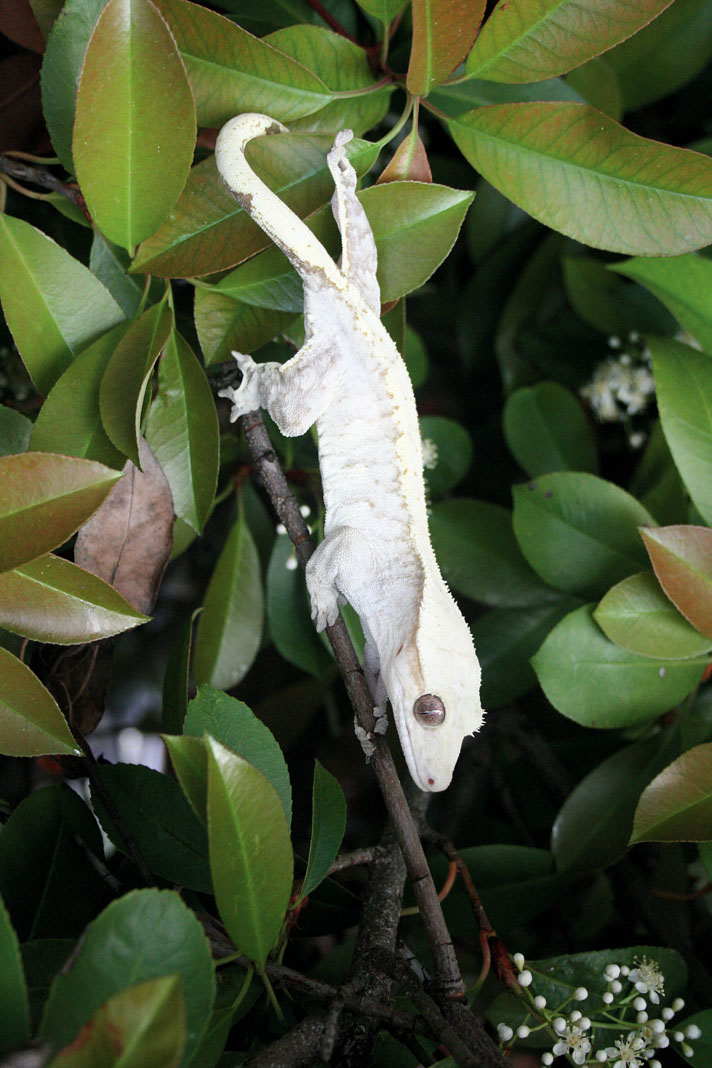
Kimberly Kay Lucas
Ghost crested gecko morph.
Crested geckos are crepuscular, shade dwellers and benefit from UVB. They are a Zone 1 animal on the Ferguson Zone for UVB. Provide a UVB light with a UVI Zone range of 0 to 0.7. Read the labels on the UVB light before you purchase to ensure it will work with your particular enclosure, as height of the enclosure and basking area will affect UVB absorption. Turn off lights at night.
The ideal temperature range for their enclosure is between 68 and 80 degrees Fahrenheit, which is generally room temperature for most households. If your home is regularly warmer than 82 degrees, a crested gecko is not the gecko for you. Hardy as these geckos are, overheating is their weakness, and they will die rather quickly if overheated.
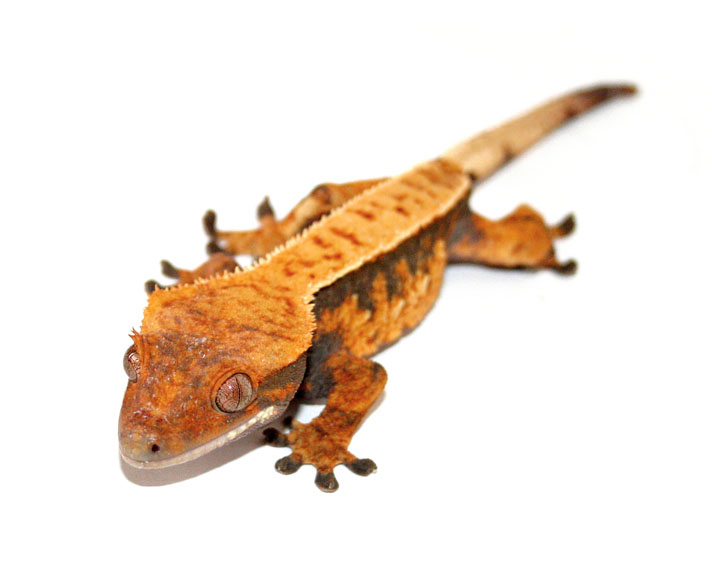
Kimberly Kay Lucas
High-contrast pinstripe crested gecko morph.
If you want to have a naturalistic look in your crested gecko enclosure by including live, pesticide-free plants, then UV bulbs will be needed. If you go this route, suspend the light fixture above the enclosure rather than resting it directly on top of the screen top. Even a low-watt bulb (I wouldn’t recommend anything more than 15 watts) can quickly heat up a metal screen top. Nighttime bulbs can also produce considerable heat, so be sure to monitor those, as well. What I have found to be an effective and cool-looking night light is a small string of red holiday lights bunched up on top of the enclosure. It doesn’t make the screen too hot, looks beautiful, and it allows nighttime viewing of your crested geckos.
Proper humidity is important to ensure proper hydration and to help your crested gecko shed properly. Low humidity can lead to health issues such as loss of toes and limbs due to a constricted shed. A healthy crested gecko will shed on a regular basis as it grows, and proper shedding is important to maintain optimal health.
The ideal humidity range for a crested gecko enclosure is between 55 and 80 percent. A combination thermometer/hygrometer, often available at pet stores that sell reptile supplies, should be kept inside the enclosure to monitor temperature and humidity. Use a spray bottle to mist the enclosure with water; once in the morning and once in the evening will usually maintain a healthy humidity level while allowing a short dry-out period during the day, which helps to reduce bacteria overgrowth resulting from excessive moisture. Your crested geckos will look forward to the nightly spray down, and they will lap up water droplets from the plants and sides of the enclosure.
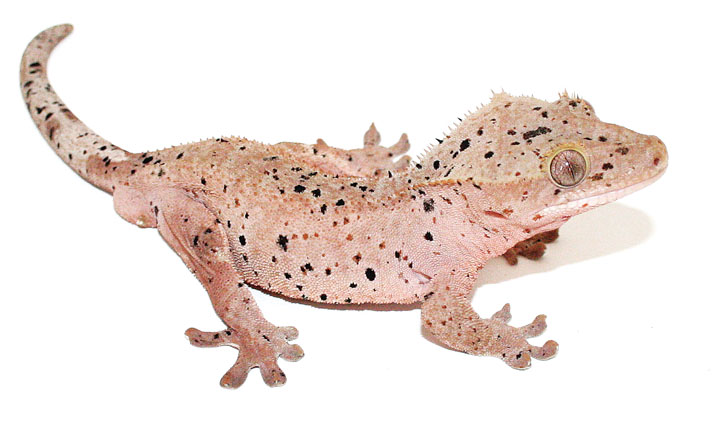
Kimberly Kay Lucas
Red super dalmatian crested gecko.
During the winter months it can be difficult to maintain higher humidity levels. Adding a moist hide can help, especially if you’ve got young geckos that are more prone to stuck sheds. Fill a plastic container with a moistened substrate such as sphagnum moss with a hole cut into the lid. The container and the hole should be large enough to allow your geckos to enter and burrow into the moss. For adults, I use a 7 by 4 by 4-inch plastic food container; a smaller container can be used for smaller geckos.
Crested geckos love to jump and climb. Their arboreal nature makes them the perfect candidates for an enclosure with lots of vines, branches and other climbing surfaces. I highly recommend anything that extends from the top of the enclosure to the bottom. Attach a twistable artificial vine to the underside of the screen top and let it spiral down to the floor of the cage. I entwine a long, plastic plant along the length of the vine, as well. A sturdy floral wire threaded through the screen can be used to attach plants and vines to the top.
Long branches of sterilized wood, bamboo or tubes of cork bark and even PVC tubing can be included as climbing sites. There is an array of arboreal hides and feeding ledges available that attach to the side of the cage using magnets; these are perfect for crested geckos. Ground shelters such as coco huts and caves can also be placed on the bottom of the cage for geckos to retreat to during daylight hours.
Choose a substrate that your gecko will not be able to ingest. For a natural look, go with a cypress or orchid bark mulch or large, artificial, wide-leafed plants arranged on the bottom to look like leaf litter. Do not use cedar products (they are toxic), sand or anything that may be easily ingested by accident.
If a natural look is not important to you, for ease of use I highly recommend using paper towels, especially for baby geckos. Paper towels are very simple to replace, and they make it easy for the geckos to locate their food and water dishes on the bottom of the cage.
Handle Gently to Avoid Tail Drop
Allowing your crested gecko to walk from hand to hand is a safe way to get your pet used to being handled. They love to jump, so I recommend sitting low to the ground-on the floor, even-when doing so. The hand-to-hand technique will allow your gecko to expend energy without feeling threatened. This will calm your gecko naturally.
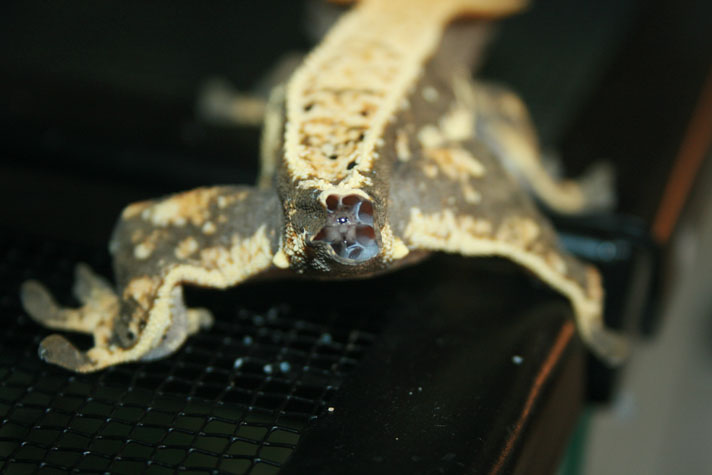
Kimberly Kay Lucas
The fracture point immediately after a gecko has dropped its tail. Within minutes, the end will close up and seal.
Crested geckos will not grow back their tails if dropped. In fact, most wild crested geckos do not have tails. A crested gecko will detach its tail in defense, leaving it behind to flop around and distract a would-be predator while the gecko flees to safety. In captivity, simply being startled or held too tightly can cause pet crested geckos to feel threatened and drop their tails. Those without their tails should not be considered any less beautiful, however. I have several tailless cresteds, and consider them just as beautiful as the ones with tails.
Food for Healthy Crested Geckos
Wild crested geckos eat nectar as well as insects, and some people recommend fruit-flavored baby food for pet geckos. I do not! In recent years, powdered diets created especially for crested geckos have become available that, when mixed with water, make it easy for gecko keepers to provide their pets with the proper nutrition. Years of research have gone into formulating a properly balanced diet for the crested gecko and in no way does baby food come close to fitting the bill. The biggest misconception about this is that you can add a little of the good diet to the bad, and doing so will make it nutritious. A properly formulated diet contains a balance of all the required nutrients so that they can be absorbed optimally. Complete diets should not be added to or blended with anything else other than water. Doing so may greatly affect how your gecko absorbs the essential nutrients it needs to stay healthy.
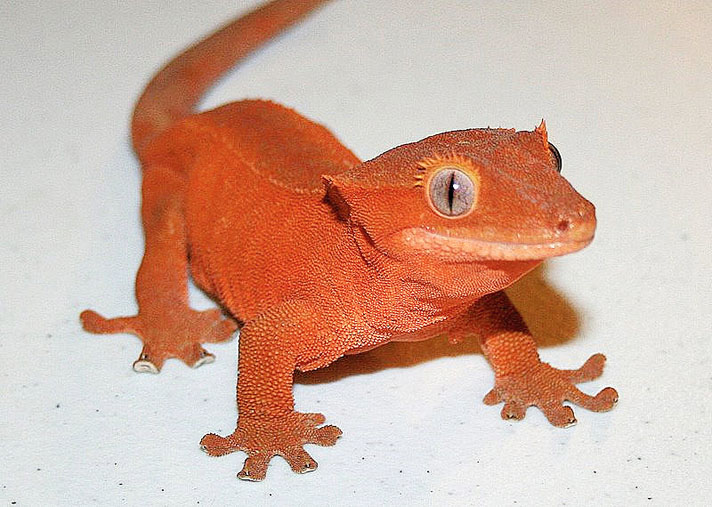
Kimberly Kay Lucas
Patternless red crested gecko.
The Repashy Superfoods Crested Gecko Diet and the Gorgeous Gecko Gourmet Crested Gecko Diet are both excellent balanced diets. Mixed with water, they create a soupy mixture geckos will lap up from a shallow dish. When offered, these foods need to be replaced within 24 hours because by the second night, all of their vitamins and many nutrients will have oxidized and fermentation will have begun. The food might look okay, but it will no longer possess the optimal nutritional values.
These powdered diets are formulated to be complete diets without the need to supplement with feeder insects. That said, insects can still be an enjoyable part of your gecko’s feeding routine. They should not be any larger than the width of your crested gecko’s head. On occasion, I have offered my geckos Vita-Bugs, crickets, Dubia roaches and Phoenix worms. Crested geckos seem to respond best to the quick movement of crickets, and watching them hunt crickets can be quite entertaining. Slower-moving feeders such as roaches and worms should be offered from a bowl. Never take insects from the wild and feed them to your geckos, as they may have been exposed to potentially harmful toxins and pesticides.
Ideal Water for Your Crested Gecko
After much research and based on my own experiences providing water to my gecko colony, I have found that ionized micro-clustered water is the best water for optimal crested gecko health. It is full of antioxidants, natural minerals and provides superior hydration. It is the only water used at my Gorgeous Gecko facility. Visit healthywaterwise.com for more information about ionized water, and to find out where to get a water ionizer.
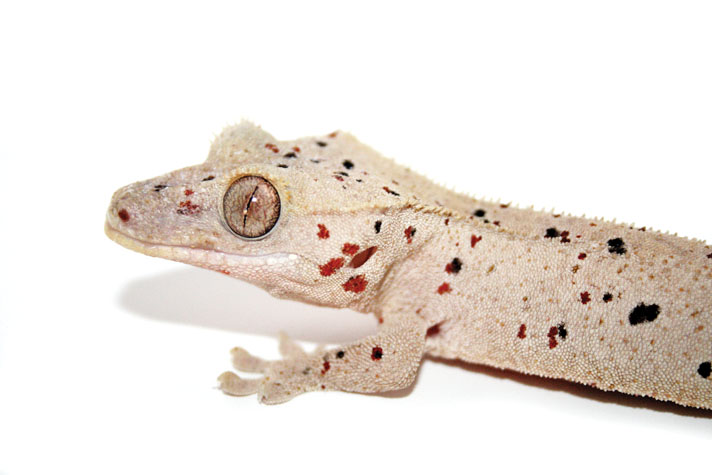
Kimberly Kay Lucas
Red dalmatian morph with multicolored spots.
You can use tap water after filtering the chlorine out; a water pitcher equipped with a simple charcoal filter will do so. Water that has had its natural minerals removed, such as reverse osmosis and distilled water, is not suitable for any reptile, including the crested gecko. Offering this type of water can be potentially harmful over the long term because water depleted of its minerals will require minerals to be leached from the gecko’s body in order to be properly absorbed.
Always provide a shallow water dish with fresh water daily, along with the mistings previously described, for optimal hydration.
Crested Gecko Morphs
Crested geckos are polymorphic, meaning they are able to produce an infinite range of color and pattern combinations. Through selective breeding, many unique color combinations have been produced and can be identifiable to even the novice breeder. Some of the most common morphs found in crested geckos are Pinstriped, Tiger, Harlequin, Dalmatian and Flame.
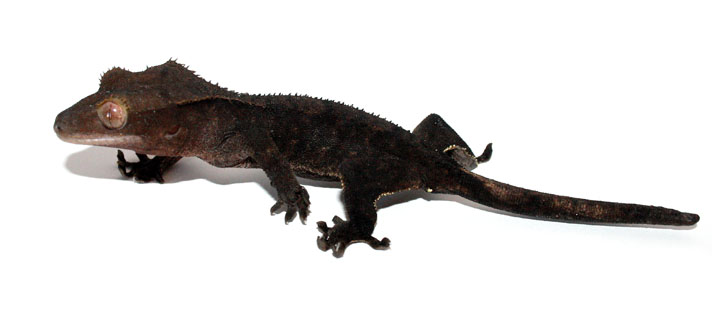
Kimberly Kay Lucas
Dark “normal” patternless crested gecko.
There are also designer, and typically more expensive, crested morphs, such as Calico or Tri-color, Sorbet Swirl, Reverse or Phantom Pinstripe, Super Harlequin and Super Dalmatian.
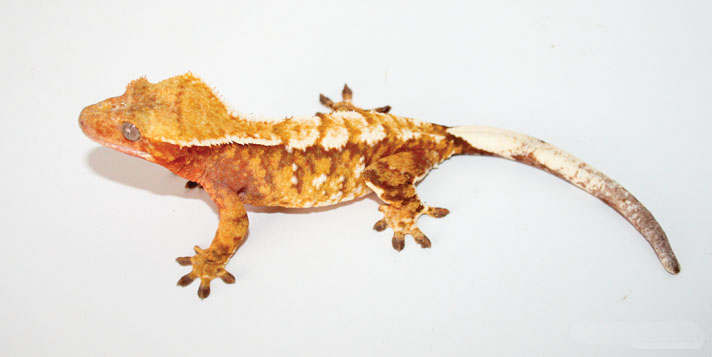
Kimberly Kay Lucas
Sunburst calico crested gecko.
New names identifying trait combinations are created every year. Typically a morph’s name will represent a selective genetic line that was bred to produce a particular pattern or color combination. Although the genetics of crested geckos are not 100-percent predictable as they are with other species of reptiles, an experienced gecko breeder can breed for the desired results. Now and then, though, even a seasoned breeder gets a surprise when a hatchling emerges from an egg displaying a new and unique beautiful and unexpected morph combination. It is no wonder so many people are drawn to the alluring beauty and charm of the crested gecko-it just keeps getting more visually stunning every year. This remarkable little gecko, now thriving in captivity, is winning the hearts of reptile enthusiasts of all ages. It’s ready to take over as the king of gecko world. Heck, it’s even born with a crown!
Kimberly Kay Lucas owns Gorgeous Gecko and has been breeding crested geckos for more than 10 years. She has developed an international reputation for consistently producing quality, healthy crested geckos, and her growing love for reptiles has led to an expansion of her brand to include gecko supplies, clothing and art. Visit her at gorgeousgecko.com and everythinggecko.com.

